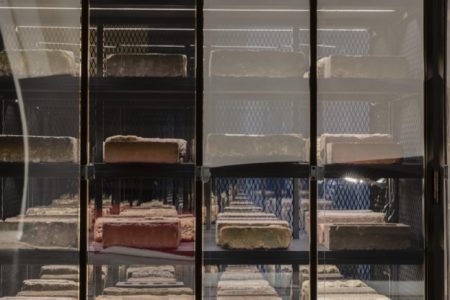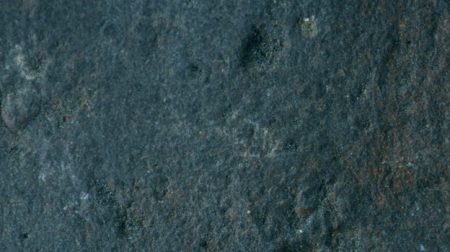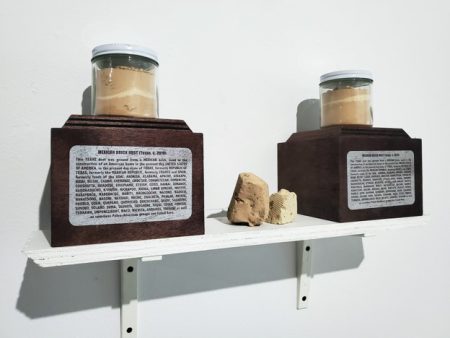
“Sous les pavés, la plage!” (“Under the paving stones, the beach!”) went the rallying cry of French students in the protests of May ‘68. Referring to the sand found beneath Paris cobblestones lifted to hurl at police and build barricades, this phrase, soon championed by the Situationists[1], came to symbolize a reclamation of freedom through deconstruction, subversion, and disruption. I thought about this as I examined bricks on a backlit display cabinet, arranged in rows of three. Although these bricks are from Houston Texas, not Paris France, and to my knowledge students haven’t tried throwing them, this exhibition at San Jacinto College Central Campus Gallery does capture something of the slogan’s subversiveness. For the past two years conceptual artist Alexander Squier has salvaged hundreds of bricks from the Houston area, which he has meticulously examined, researched, and here displayed as The Houston Brick Archive.
In and of themselves, the bricks aren’t very interesting to look at. The cabinets, occupying the middle of the gallery and made of metal and mirrored Plexiglas, show the bricks repeated to infinity. It’s briefly awe-inspiring, but it quickly collapses into monotony. There is no labeling or evident taxonomy — I can appreciate this application of the Situationists’ dérive[2] to an archive, but on my initial viewing I ultimately struggle to get much out of it. Thankfully, there is much more to this exhibition than the physical archive itself. Maybe it will be more interesting after having considered the rest of the exhibition?

A looping video projection commands the wall at the gallery’s far end. Sonic Surface Studies explores brick surfaces in extreme closeup, like looking down from a drone slowly panning over an alien landscape. Accompanying sounds by Edwin Terrell are made from the bricks’ sonic signatures. Unfortunately, this was audible only through the projector’s built-in speaker. I later found the video on Squier’s website. Listening closely with proper speakers, the soundscape is tense and hypnotic, at times a bit like bamboo wind chimes being dragged through a room with a vaulted ceiling. I would have loved to hear it that way in the gallery. It would have heightened the bricks’ alterity, the aesthetic equivalent of plucking them up from the street, rendering them strange by a simple change of context.

On the far end of the gallery a map shows the bricks’ provenances as migration patterns. Squier has traced particular bricks to particular workshops, then establishing the myriad of sources of its raw material and demographic information of those who labored in their production. Here the Archive’s own version of Sous les pavés, la plage! begins to emerge, in which the material and social elements are decoupled. This decoupling renders the human and material aspects visible. This is most fully realized in Texas Brick Dust, in which two small glass jars of fine sandy powder sit side-by-side atop wooden boxes on a shelf jutting from the wall. Between them sits two chalky lumps, remnants of hand crushed, unfired Mexican bricks. On each wooden box a text reads:
MEXICAN BRICK DUST (Texas, c. 2019)
This TEXAS dust was ground from a MEXICAN brick, used in the construction of an American home in the present day UNITED STATES OF AMERICA, in the present day state of TEXAS, formerly REPUBLIC OF TEXAS, formerly FRANCE and SPAIN, formerly lands of the ADAI, AKOKISA, ALABAMA, APACHE, ATAKAPA, BIDAI, BILOXI, CADDO, CHEROKEE, CHOCTAW, COHUILTECAN, COMANCHE, COUSHATTA, DEADOSE, ERVIPIAME, EYEISH, GEIES, HAINAI, JUMANOS, KADOHADACHO, K’ITAISH, KICKAPOO, KIOWA, LIPAN APACHE, MAYEYE, NABAYDACU, NABEDACHE, NABITI, NACOGDOCHE, NACONO, NADOCO, NANATSOHO, NASONI, NECHAUI, NECHE, QUERECHO, QUICUCHABE, QUIDE, SALINERO, SIMONO, SOLANO, SUMA, TAOVAYA, TAWAKONI, YAQUI, TEYAS, TOBOSO, TONKAWA, UNPUNCLIEGUT, WACO, WICHITA, XARAMES, YOJUANE as well as countless Paleo-American groups not listed here.
Squier lays bare the relationships between raw materials, people, and power. It’s a deft twist of Situationist humor, taking the meaningfulness that’s supposed to be intrinsic to an archive and heaping it into jars of dust. The process of accessing the archive’s contents is the same as destroying the archive. Guy Debord would have tipped his scarf. Humor aside, this archive asks us to look at our built environment with greater empathy. Returning to the Brick Archive, I now see indentations made by hands and fingers of those who labored in their production, revealing each one a unique document of a complex history. To find the beach, one needs to look no further than within a brick.
Entre les murs, la plage!
Within the walls, the beach!
–Steve Kemple
[1] See McKenzie Wark’s The Beach Beneath the Street: The Everyday Life and Glorious Times of the Situationist International (London: Verso, 2011).
[2] “One of the basic situationist practices is the dérive [literally: “drifting”], a technique of rapid passage through varied ambiances. Dérives involve playful-constructive behavior and awareness of psychogeographical effects, and are thus quite different from the classic notions of journey or stroll.” (Guy Debord, “Theory of the Dérive”, Les Lèvres Nues #9, [Nov. 1956] translated by Ken Knab).